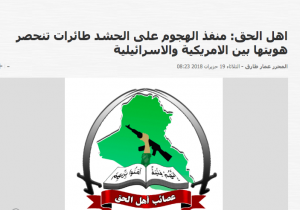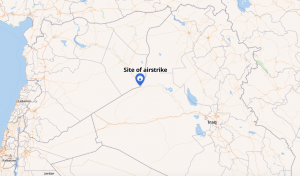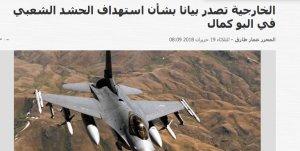Breaking: Mystery surrounds overnight airstrikes on pro-Syrian regime fighters
June 18, 0800 hours Jerusalem time
After Syrian regime blamed US and US denied the attacks, questions remain over who carried out airstrikes in strategic Euphrates valley that allegedly killed pro-Iranian Kata’ib Hezbollah militia members
Parts of these articles originally appear in The Jerusalem Post between June 18 and June 20.
Just after midnight in the first hours of Monday morning airstrikes targeted Syrian regime targets in the Euphrates valley near the Iraqi border. The strikes hit in the proximity of Syrian military positions near Albu Kamal in a village called Al-Hari. They reportedly killed members of Iranian-backed Shi’ite militias.
Syrian state media reported almost immediately that the strikes were carried out by the US and pointed to the US-led anti-ISIS Coalition as the culprit. Within hours the claims that the US had struck the Syrian regime troops was downgraded a bit to “probably” but headlines in pro-Syrian regime media, including in Iran, claimed the US was targeting Syria.
“No member of the U.S.-led coalition carried out strikes near Albu Kamal,” Major Josh Jacques, a U.S. Central Command spokesman, told Reuters.
A US Central Command spokesman Major Josh Jacques told Reuters that “no member of the US-led coalition carried out strikes near Albu Kamal.” The US does not usually deny involvement in airstrikes that it has carried out. The clear denial indicates the US was not involved. In the past the US has struck at pro-regime units to support its Syrian Democratic Forces partners who have sometimes been targeted by the Syrian regime and its allies. Later the press affairs office of the Coalition said the US is “aware of reports of a strike near Albu Kamal, Syria that killed and wounded several Katai’b Hezbollah members. There have been no strikes by US or Coalition forces in that area.”
Kata’ib Hezbollah is an Iraqi paramilitary group. Its leader Abu Mahdi al-Muhandis served alongside the Iranian Islamic Revolutionary Guard Corps in the 1980s and is close to Quds Force commander Qasem Soleimani. In January 2017 he told Al Mayadeen that Lebanese Hezbollah was active in Iraq and provided evidence for Iran’s deep influence across Iraq to Syria and Lebanon. Since 2017 Kata’ib Hezbollah has been an official paramilitary force of the Iraqi government under the Popular Mobilization Units.
Lebanon Facilitates Hezbollah Fighter’s Travel Out Of Middle East To Create Terror In West
So who would carry out an air attack on an Iraqi Shi’ite paramilitary group in Syria? There are other air forces that operate in Syria that are capable of carrying out airstrikes. In April the Iraqi government carried out airstrikes against ISIS pockets in Syria near the border. It coordinated with the Syrian regime and coordinated closely with the Coalition, since the Coalition is in Iraq to support the central government’s anti-ISIS campaign. The Iraqi government wouldn’t knowingly target its own paramilitaries in Syria.
Syrian state media has blamed the US for airstrikes before. In April missiles hit a Syrian base near Homs. Later foreign reports placed responsibility on Israel for that airstrike. The full details of the April airstrike are not known, but the pattern, in which the regime quickly blamed the US, is similar to what happened Monday morning.
Why would the regime falsely attribute an attack to the US. One reason is because Syrian air defense might not know who was carrying out the attack but would know from which direction the attack came. Planes flying into the Euphrates valley would be assumed to be Coalition planes. The regime also wants to blame the US in order to ramp up Russia-US tensions and it wants to downplay the ability of Israel to strike deep in Syria.
The Syrian Observatory for Human Rights claims that “sites and points of the Lebanese Hezbollah militias and other militias loyal to the regime forces of non-Syrian nationalities were targeted by warplanes, which are still unknown.” SOHR says 40 militia members were killed while Orient News says around 30. Other sources said 38 foreign fighters were killed in the airstrike.
One twitter account has pointed the finger at Israel. IntaNewsAlerts claims that “reports now surfacing that this attack should actually be attributed to Israel.” Reuters asked about the reported air strikes and an Israeli military spokeswoman said “we do not comment on foreign reports.” However the airstrike comes a day after Prime Minister Benjamin Netanyahu warned that Israel would continue to take action against Iran’s attempts to entrench itself in Syria. “We will take action and are already taken against efforts to establish a military presence by Iran and its proxies in Syria.”
Netanyahu: first, Iran must walk away from all Syrian territory, and secondly, we will act and act now against Iranian attempts and attempts by Iran’s agents to military positioning near the Israeli border and inside the Syrian rear…We will work against this posturing throughout the Syrian territory.
Is The US Deploying In Sinjar (Shingal)? If So, Why? A Look At The Emerging Reports
The area near Albu Kamal where the airstrikes were carried out is a strategic corridor and border crossing from Iraq to Syria. It is an area where Iranian-backed Shi’ite militias have operated for more than a year. They have been present to fight ISIS but there are also concerns that Iran is seeking a “land corridor” via Iraq to Syria and that this area would be used as a way to transport militias and weapons. The presence of Kata’ib Hezbollah in Syria points to the way the network of Iranian-backed Shia militias, including those that are officially part of the government in Iraq, create a network from Beirut to Tehran.
June 18, 1600 hours Jerusalem time
CNN: US official says Israel carried out airstrike
Cutting off Iran’s “road to the sea” in Syria
A US official claims Israel struck Iranian-backed Iraqi militia in Syria, now Tehran must think twice about moving fighters from Iraq to Syria
Tehran must re-adjust its policy in Syria a day after an airstrike killed and wounded dozens of Iranian-backed Shi’ite Kata’ib Hezbollah members in Syria near the Iraqi border. The first of its kind strike targeting Iraqi militias who have been crossing into Syria to aid the Syrian regime since last year seeks to interdict Iran’s “road to the sea” by striking at a strategic area near the border town of Albu Kamal.
A US official told CNN Monday that the airstrike targeting Kata’ib Hezbollah members was carried out by Israel. This came eighteen hours after the Syrian regime had blamed the US-led coalition for the airstrike that hit near Syrian regime soldiers and their foreign militia allies.
The context of the airstrike is Iran’s attempt to construct a network of allies from Iraq through Syria to Hezbollah in Lebanon. In 2016 pro-western sources in Iraq warned that Iran was building a “road to the sea.” In December 2017 The New Arab reported that convoys of unmarked vehicle had passed into Syria from Iraq through checkpoints manned by the Hashd al-Shaabi, the mostly Shi’ite militias that are called Popular Mobilization Units (PMU). Understanding the role of these militias is complex but necessary to understanding why an airstrike on them in Syria is so important. These units form one of the patchwork of similar groups Iran’s Islamic Revolutionary Guard Corps has sought to support, train and seed throughout the region. Along with Hezbollah in Lebanon Iran also helped train units in Syria. Ambassador to the United Nations Danny Danon said in April that Iran had trained 80,000 militia members in Syria.
The Iraqi members of the PMU are thought to number 100,000 and include groups such as the Badr Brigade and Kata’ib Hezbollah. Kata’ib Hezbollah’s leader Abu Mahdi Al-Muhandis is a close ally of IRGC Quds Force commander Qasem Soleimani and in 2017 he even bragged that his units in Iraq were working with Lebanese Hezbollah. Since 2017 units like Kata’ib Hezbollah under the umbrella of the PMU have been incorporated into the official paramilitary forces of the Iraq. Iraqi Prime Minister praised the militias as the “hope of Iraq and the region,” in October 2017 when former US Secretary of State Rex Tillerson urged the militias to “go home” after the war with ISIS was complete. Instead of going home the militias formed their own political party called Fatah Coalition led by Badr’s Hadi al-Amiri. Fatah came in second place in Iraq’s elections and has partnered with Muqtada al-Sadr to seek to form a coalition government. Kata’ib Hezbollah has called for the US to exit Iraq, a reminder that it once fought the Americans after 2003 and the US designated it a terrorist organization in 2009.

Asaib Ahl al-Haq’s condemnation
Up until the June 18 airstrike Kata’ib Hezbollah’s 45th brigade of the PMU was operating in Iraq and Syria, ostensibly carrying out anti-ISIS operations near the border. After the air strike the Iraqi government Joint Operations Command sought to distance itself from its own units that had crossed the border, alleging according to AlSumaria TV that those members who crossed were not “regular” units.
In addition on Tuesday, Iraq’s Foreign Ministry condemned the air strike as aiding ISIS, but did not blame either Israel or the US. The Shia militia Asa’ib Ahl al-Haq, a part of the PMU, condemned the US and Israel for the air strike, alleging they seek to divide Iraq. The Fatah political coalition urged Iraq to protect its forces in Syria, even though the Iraqi government denies its official forces are there.
Iraq, which is an ally of the US and a partner of the US-led coalition understands the presence of its militias are more controversial after Secretary of State Mike Pompeo’s May speech excoriating Iran’s nefarious role in Iraq. “In Iraq, Iran sponsored Shia militia groups and terrorists to infiltrate and undermine the Iraqi Security Forces,” Pompeo said. Kata’ib Hezbollah forces have even flown their flags on US M1A1 Abrams tanks.
Netanyahu said Sunday that he spoke to Pompeo over the weekend. Combined with the CNN report that Israel carried out the airstrike, the picture painted for Iran and its allies in Iraq is that the corridor to the sea may be closing. The message to Kata’ib Hezbollah is to leave Iraq. On June 17 Netanyahu tweeted in Arabic that “Iran must walk away from all Syrian territory…we will work against [Iranian] posturing throughout Syrian territory.”
June 19 1200 hours
Al-Jarida: Russia and Washington approved Israel’s airstrike
Report: Israel struck Iranian-backed Shia militia in Iraq with Russian approval
Kuwaiti newspaper Al-Jarida reported on Tuesday that Israel carried out an airstrike on a Shi’ite militia in Syria with the approval of both Moscow and Washington.
On Monday an airstrike killed and wounded dozens of members of Iraq’s Kata’ib Hezbollah, an Iranian-backed Shia militia which has been operating near the Iraqi border in Syria. According to Al-Jarida, Israel carried out the airstrike and killed 52 members of the militia. It came after Prime Minister Benjamin Netanyahu had said that Israel would strike Iranian forces throughout Syria and that Iran should leave Syria. “Russia now considers that Tehran is playing a role recently that is disrupting Russia’s goals,” the report states. Russia and Iran are the main allies of the Syrian regime in Damascus, but they do not always see eye to eye on policy. Iran wants to extend its influence in Syria and create a corridor of influence from Tehran via Baghdad and Damascus to Beirut, while Russia is mainly interested in strengthening the regime of Bashar al-Assad. Iran’s drive for regional hegemony, which threatened Israel, has the possibility of destabilizing the Assad regime, as Tehran uses the regime for its own ends.
The Al-Jarida report notes that the airstrike appears to make Tehran’s route to the Meditteranean more difficult. A second report at the same newspaper on Tuesday also claimed that the airstrike was aimed at sending a message to Iran to remove its forces and militias it supports from Syria. Kata’ib Hezbollah has close relations with the Islamic Revolutionary Guard Corps Quds Force and also with Lebanese Hezbollah.
Al Hurrah Iraq correspondent : Security forces receive members of Hezbollah brigades accused of shooting at a checkpoint in Palestine Street in Baghdad which lead to the killing of one security element & the wounding of three others. https://t.co/5O5RLREzrp
— Tom Hansen (@Observer46664) June 20, 2018
Updates June 20: Fallout from tensions continue in Iraq
Kata’ib Hezbollah members allegedly shot at a checkpoint in Baghdad in the wake of the attack. Reports indicated that “The Iraqi Hezbollah militiaman accused of attacking a checkpoint in Baghdad was handed over to security forces under the supervision of Interior Minister Qassim Al Araji.”
I was holding off until I knew for sure.
Hezb Battalions clashed with ISF in E Baghdad and now there are negotiations with the commanders.
— TØM CΛT (@TomtheBasedCat) June 20, 2018
The ISF cordoned off an area around a Kata’ib Hezbollah headquarters and there were negotiations. Ali Choukeir reported “#Iraqi police surrounded the #Baghdad headquarters of the pro-#Iran Hezbollah Brigades Wednesday, after an armed clash with law enforcement left three people wounded, an interior ministry source said.”
According to David Witty on June 20, “Iraqi Police stop car belong to PMU (Hashd) Kata’ib Hezbollah militia member in Baghdad. 5 militia vehicles respond & fire on police. 2 police injured & 1 militia. Police surround Hezbollah HQ in Baghdad & arrest suspects.”
Al-Ghad: Kata’ib Hezbollah acquires anti-aircraft missiles
On Wednesday Al-Ghad reported that “Iraq’s Hezbollah battalions [Kata’ib Hezbollah] are preparing to launch a new war with US and Israeli planes on the Iraqi-Syrian border after their deliberate targeting [on June 18], which resulted in the deaths of large numbers of their dead and wounded, a source familiar with the crowd said Wednesday.” Allegedly they had obtained “sophisticated precision missiles.”



